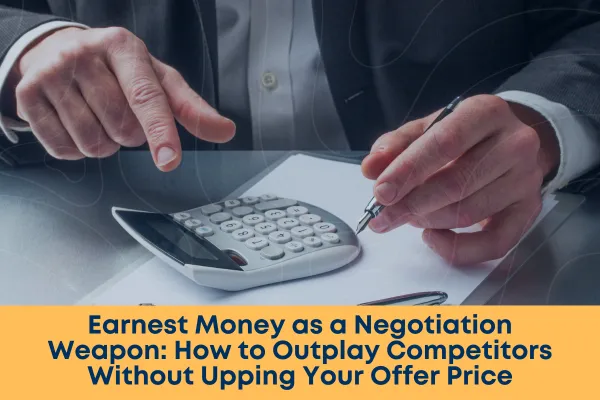
Earnest Money as a Negotiation Weapon: How to Outplay Competitors Without Upping Your Offer Price
Earnest Money as a Negotiation Weapon: How to Outplay Competitors Without Upping Your Offer Price
In today's fiercely competitive real estate market, it's no longer enough to rely solely on higher offers to win deals. Savvy investors understand that leveraging your Earnest Money Deposit (EMD) as a strategic tool can give you a distinct edge over competitors—without having to raise your offer price. It’s not about spending more; it’s about being smarter.
Here’s how professionals can elevate their negotiation game using earnest money as a powerful, strategic weapon.
1. Signal Serious Intent Without Financial Overstretching
In competitive real estate transactions, sellers are not just looking at the offer price—they want to know you're serious about closing. By offering a larger EMD, you demonstrate strong intent and financial capability, immediately signaling to the seller that you're fully committed to the deal. This level of commitment can often sway a seller without requiring you to push the price higher.
However, be cautious: don’t simply increase the EMD to a reckless amount. The key lies in offering just enough to outperform competitors, while protecting yourself with contingencies (more on this later).
2. Show Flexibility with Contingencies
Many buyers may hesitate to make significant concessions on contingencies, fearing it may expose them to too much risk. But this is where you can capitalize: removing or minimizing contingencies in your offer, while keeping your EMD higher, gives the seller a sense of security without you inflating the offer price.
For instance, removing financing contingencies (if you're pre-approved or have solid cash reserves) or tightening your inspection period can give you an advantage over other buyers who may offer more money but come with more deal-breaking contingencies. This approach helps you mitigate the perception of risk in the seller's eyes.
3. Shorten the Earnest Money Deposit Timeline
Another way to leverage your EMD is by offering to release the deposit faster than your competitors. Sellers, especially in a fast-moving market, want to know they’re working with a buyer who’s ready to commit, and offering to release EMD quickly signals confidence and readiness.
For example, offering to release your earnest money to escrow within 24-48 hours of mutual acceptance rather than waiting the standard period can position your offer as more appealing—again, without raising the purchase price.
4. Earnest Money in Lieu of Price Escalation
Many buyers in competitive situations offer price escalations, committing to outbid other offers by a certain margin. This can quickly drive up prices, stretching budgets and impacting your return on investment (ROI).
Instead, offer a larger EMD upfront as a negotiation tactic to pre-empt price escalations. Sellers often see a larger EMD as a sign that you’re less likely to back out of the deal, reducing the risk for them, and making your bid appear stronger even without an escalation clause.
5. Earnest Money as Leverage in Negotiations
Post-inspection negotiations are often where deals can fall apart, particularly if you uncover issues with the property that could require repairs. Having a larger EMD in place gives you leverage during these conversations.
Rather than asking for a reduction in price after the inspection, consider using the EMD as part of the negotiation. For example, if the inspection reveals issues, you could offer to forgo the repair ask in exchange for a minor credit or adjustment on closing terms, while leaving the EMD intact. This reinforces your commitment, while still protecting your interests.
6. Minimize Seller Anxiety with Risk-Free Deal Structuring
One of the main concerns sellers have is whether the deal will close. A buyer with a strong offer, backed by a substantial EMD, provides a sense of security that the deal is less likely to fall through. However, you can sweeten the deal further by adding structured clauses around the earnest money release that reassures the seller while keeping you protected.
For example, releasing portions of the earnest money deposit after certain contingencies are met (like financing approval or inspections) can help you stand out as a flexible and serious buyer. This tactic is especially powerful in markets where sellers prioritize deal certainty.
7. Use Non-Refundable Deposits Strategically
In particularly competitive situations, some buyers offer non-refundable deposits to win over sellers—this may seem like an extreme risk, but it can be executed intelligently. Consider offering a portion of your EMD as non-refundable only after key contingencies are cleared. This gives the seller confidence while allowing you to reduce risk exposure.
This can also function as an alternative to higher offer prices, appealing directly to the seller’s desire for commitment without blowing your budget.
Conclusion: Smart Leverage in Competitive Markets
Leveraging your Earnest Money Deposit as a negotiation tool is about outthinking the competition, not outspending them. By increasing your EMD strategically, shortening timelines, minimizing contingencies, and using creative negotiation tactics, you position yourself as a highly desirable buyer—while keeping your offer price in check.
In a market where buyers often focus solely on raising the purchase price, professionals who deploy earnest money strategically will find themselves winning more deals without unnecessary financial strain. Remember, real estate success often comes down to who can negotiate the smartest, not just the highest.